Nonprofit Social Media Trends for 2025: What Your Organization Needs to Know to Succeed
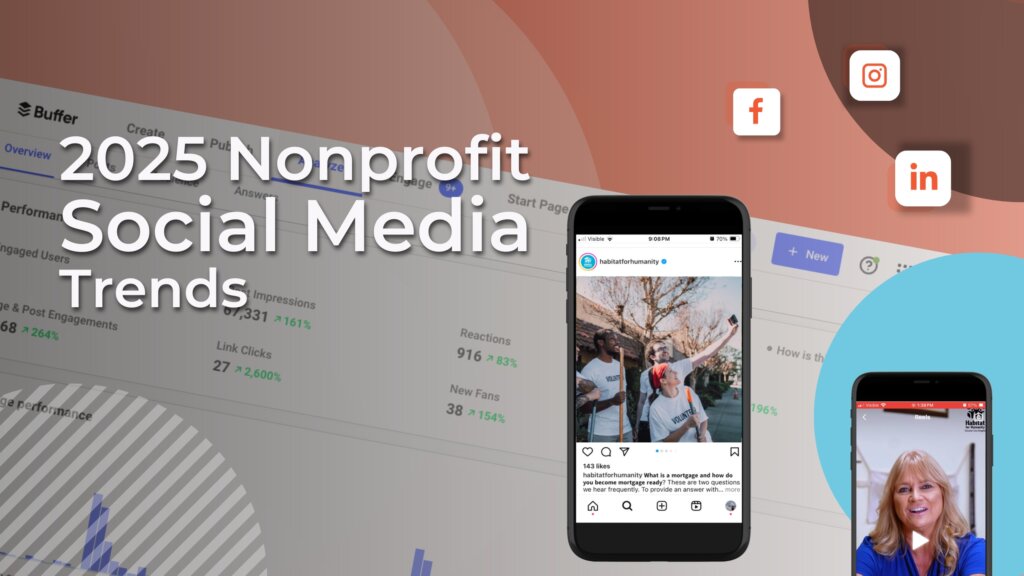
It can be overwhelming to keep up with the latest social media strategies. It’s hard enough to get content out the door let alone test new things and catch-up with the latest trends.
However, social media has become one of the most important communications channels that nonprofits have to connect. Not to mention that it’s a critical way to continue to build relationships with the younger generation of new donors.
And, social media giving is growing. According to the Associated Press, GivingTuesday 2024 saw an estimated $3.6 billion in donations, marking a 16% increase from the $3.1 billion raised in 2023.
Furthermore, a recent survey by Double the Donation, 32% of donors that give online like to give through social media. The largest share of respondents.
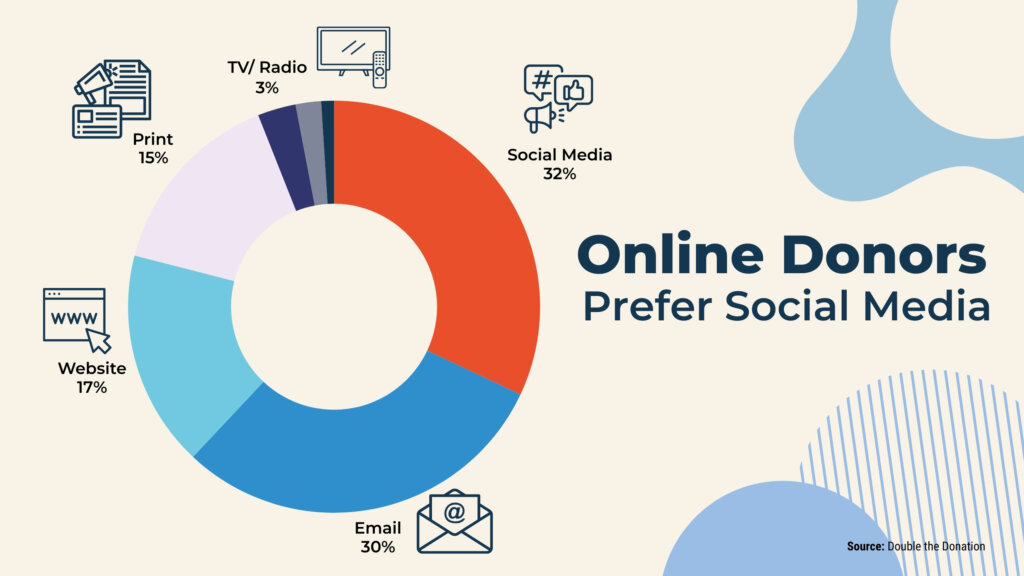
The bottom line: social media is a critical part of your fundraising and communication strategy.
Even better news for nonprofits is that many of the latest tools and strategies will actually save you and your team time, while boosting engagement.
Let’s dive into the trends (and tools) that will be reshaping the way that social media works for your mission in 2025 and beyond.
Why Nonprofit Social Media Trends Are Unique
Nonprofits have different goals and challenges on social media than commercial brands and for-profit organizations. Instead of selling products, you’re inspiring action, building trust, and showcasing real impact.
But this comes with unique hurdles:
- Limited budgets mean every dollar needs to stretch further.
- Small teams juggle multiple roles, leaving little time for proactive social strategies.
- Demonstrating impact is critical to engage donors and volunteers – especially younger ones.
Here’s the truth: Staying current with trends can help you overcome these challenges and make your social media efforts more impactful.
10 Nonprofit Social Media Trends in 2025
1. Short-Form Video: The Engagement King
Short-form video is no longer optional—it’s essential. According to Classy.org, 41% of Gen Z donors are inspired by social media content, with video being their preferred format. Authenticity, not perfection, is what resonates.
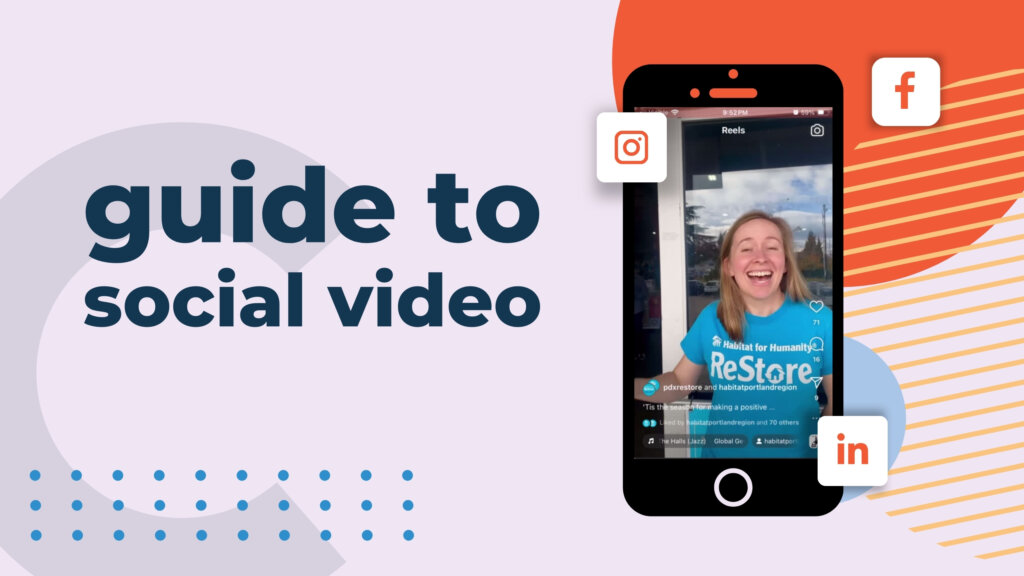
How to start:
- Use Community Connect’s social media video guide. It includes 40+ ideas, scripts, questions and shotlists.
- Focus on recording quick, 30-second interviews with staff or volunteers on your phone.
- Capture candid “day in the life” moments showing your team in action.
Tools to make editing easy: Canva and CapCut are user-friendly, free tools to edit videos with minimal effort. The paid version of CapCut has AI features that will edit your raw video for you, which makes short form video a breeze.
2. AI: Your New Digital Teammate
No. AI will is not replacing people.
However, AI tools, like ChatGPT, can be a great assistant in your work by making you a lot more productive.
Here are some things that AI does really well:
- Suggests content ideas or drafts that you can customize.
- Analyzes your top-performing posts to recommend content ideas.
- Rewrites content for clarity, brand voice and structure.
- Edits blog posts and stories
- Edits and generates images (check out Canva’s features)
- Edits videos (check out CapCut social media video editor)
- Develops a content calendars and campaign messaging.
There are literally endless uses for AI in modern nonprofit communications work. Once you start to mess around with the capabilities it opens a whole new world of possibilities.
Coming Soon: Community Connect is currently working on training resources to help you use AI effectively—stay tuned!
3. Engaging Local Influencers: Amplify Your Mission
Local influencers can be a game-changer for your nonprofit’s visibility and credibility.
We’re not talking about viral pranksters or celebrities—you’ll find a whole world of community-minded influencers who are eager to partner with powerful nonprofit brands.
Local influencers can help you grow your following and even lead to co-branded campaigns that amplify your impact.
How to start building influencer connections:
- Create a List: Identify influencers in your area, such as media personalities, sponsors, nonprofit collaborators, government agency partners or community leaders.
- Engage on Social Media: Use tools like Hootsuite to track and follow their posts. Regularly comment or share content to start building relationships.
- Make It a Habit: Dedicate just 15 minutes a week to engaging with influencers’ posts—comment, like, and share content where it makes sense.
- Coordinate Co-Branded Campaigns and Posts: Not everything about social media needs to be organic. To get started, work with brands you’re already working with, like your sponsors.
4. Proactive Engagement + No More “Post and Ghost”
OK. So, commenting and engaging in the online conversation isn’t new in 2025, but it more important than ever before.
And, it isn’t just about replying to comments on your post. It’s time for you to proactively engage with other partners and community organizations.
Social listening and proactive engagement are key. According to Hootsuite’s 2025 Social Trends Report, organizations that prioritize engagement and commenting see a 41% boost in reach.
How to get started with community engagement:
- Develop a list of sponsors, community influencers and accounts with large followings.
- Dedicate 15 minutes weekly to reply to comments and direct messages.
- Use tools like Mention or Hootsuite to track relevant hashtags, accounts or social conversations that you can engage with.
Engagement doesn’t have to be overwhelming; consistency is what counts. Follow our guide to building nonprofit social media engagement more consistently on your channels.
5. User-Generated Content: Your Secret Weapon
User-generated content (UGC) saves you time but more importantly it’s an authentic view into an experience with your organization. These posts also get more engagement than your nonprofit’s posts.
BlueWing’s research shows that UGC performs 29% better than organizational content.
The best part: Habitat has a natural advantage to create UGC because of all of the volunteers you engage with. Take advantage of this!
Here are a few tips on encouraging UGC:
- Ask volunteers and program participants to submit photos or testimonials (with permission).
- Create a fun competition on your construction site to see which volunteer can create the best content. Award prizes on a quarterly basis.
- Coordinate UGC with corporate sponsors and group builds ahead of time – they are looking to showcase their brand as much as you are!
- Create a branded hashtag for supporters to share their stories.
- UGC should be paired with your active listening, sharing and commenting on their content to get the biggest engagement.
Pro tip: use the pre-build one-pager from our Corporate Partnership marketing toolkit to encourage group builds to coordinate UGC opportunities.
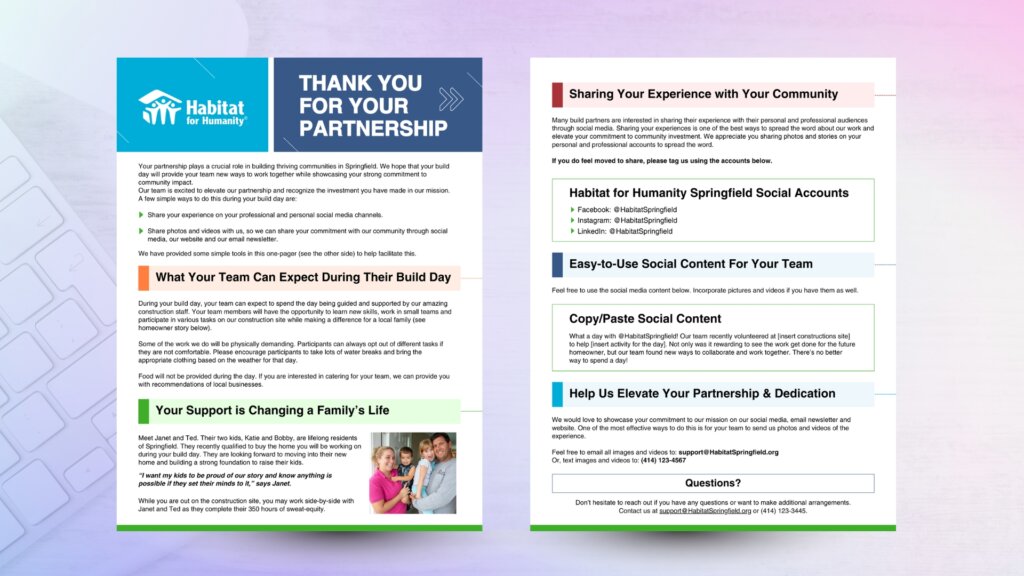
6. Carousel Posts: Showcase More in One Post
The data is clear: carousel posts—those with multiple images, videos or slides—are outperforming single-image posts on Instagram and Facebook.
Why they work:
- They encourage users to swipe through multiple pieces of content, increasing time spent on your post.
- They’re perfect for breaking down complex topics, sharing multiple event photos, or telling a step-by-step story.
Things to try with your carousels:
- Highlight “before and after” moments of your work (e.g., a deck before and after being repaired).
- Share a “Top 5 Tips” series or a step-by-step guide.
- Use them to showcase event photos, ReStore stock or volunteer highlights.
- Utilize trending music on your carousels (see tip #8).
- Use a mix of still images and videos in your carousel to boost engagement.
Pro Tip: Try repurposing your carousel images and videos as stories or reels to get even more bang for your buck.
7. Paid Social Media Strategy Doesn’t Have to Break the Bank
The truth is that organic reach is declining across all social platforms – especially for company and nonprofit pages. We’re in an era of “pay for reach” – unpaid content isn’t enough.
The good news: a small investment in paid social content can make a significant difference. And, you can grow your following significantly with just a few dollars a day.
Why paid content matters:
- Targeted Reach: Platforms like Facebook and Instagram let you target specific demographics (age, location, interests).
- Increased Visibility: Paid ads ensure your posts reach the right people, not just those who already follow you.
- Cost-Effective: Even a small monthly budget of $50–$100 can amplify your message to thousands of potential donors or volunteers.
How to Start:
- Set a budget that works for you.
- Create a clear goal that you want to measure “success” by – reach, new followers, conversions, etc.
- Boost top-performing posts to increase visibility.
- Test ads that highlight your impact stories or fundraising campaigns.
- Use retargeting ads to re-engage website visitors or past donors.
A paid strategy doesn’t need to break the bank—it just needs to be intentional and measurable.
8. Incorporating Trending Music on Instagram to Boost Engagement
Music is a powerful engagement tool, especially on platforms like Instagram Reels. Posts that use trending audio often see increased visibility because these platforms prioritize trending sounds in their algorithms.
How to use trending music:
- Stay relevant by regularly checking trending audio lists on Instagram.
- Choose music that aligns with your message (upbeat tracks for celebrations, softer tones for storytelling).
- Pair it with short-form videos, like volunteer highlights, homeowner stories and volunteer experiences.
Pro Tip: If you don’t have the rights to use specific tracks, platforms like Instagram offer a library of royalty-free or trending sounds you can easily add to your posts. Canva and CapCut also have royalty free libraries you can use.
9. Metrics That Matter: Measuring Your Success
You have limited time. So, it’s best to spend it on things that are working.
But, how do you know what’s working? Tracking social metrics are critical to improving your strategy over time and getting more efficient. To do this, you need to figure out what to measure, and how to report it.
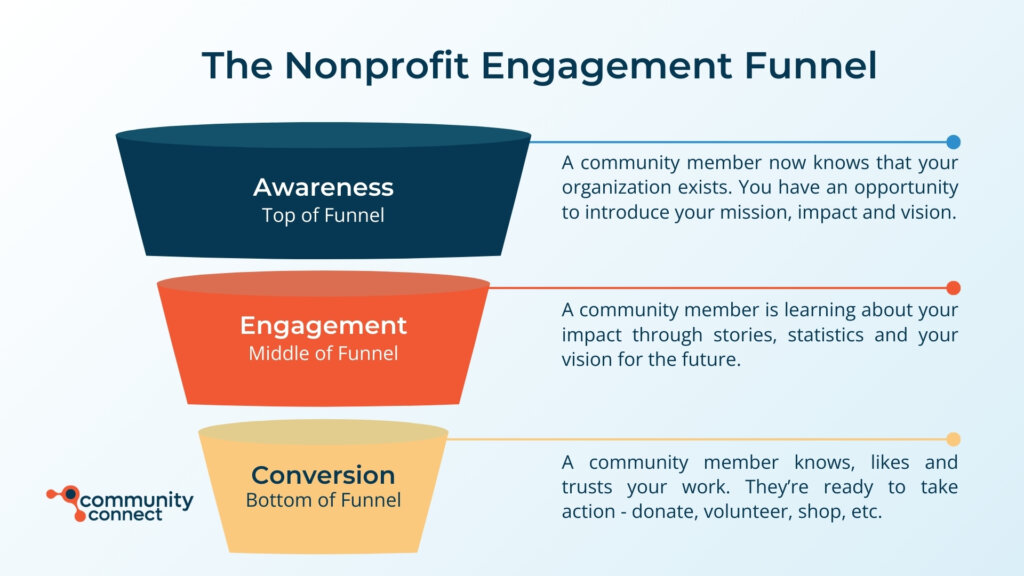
Here’s how to get started:
- Pick one goal you want to improve – awareness, engagement, action.
- Pick the metrics that best represent that goal.
- Build a way to report these metrics at least monthly to show progress.
- Assess on a post-by-post basis the types of content that work best.
Pro tip: follow our guide to measuring nonprofit social media success. It will help you select the metrics that are most useful to you.
10. Social Media Management Made Easier
With limited time and resources, smart tools are your nonprofit’s best friend. Scheduling platforms like Buffer and Hootsuite help you plan, post, and even optimize your content.
Time-saving practices you should follow:
- Build a monthly content calendar with themes, events and key milestones – or use Community Connect’s as a starting point.
- Plan, write and schedule your posts in batches (2 – 4 weeks at a time) using a platform like Buffer or Hootsuite.
- Spend time to build a social media strategy that incorporates content “pillars” (or regular topics) so you don’t always need to develop content from scratch.
- Take advantage of Community Connect’s pre-made social media calendars and monthly content services.
- Use AI content generation features in Buffer. Or build an AI assistant in ChatGPT to ensure your brand voice.
- Draw inspiration from other nonprofits – no need to recreate the wheel!
By automating repetitive tasks, you’ll have more time to focus on meaningful engagement.
The Secret to Sustainable Social Media Success
10 new things to focus on! That feels overwhelming…
The key to success isn’t doing it all—it’s making progress with small steps over time.
Here’s how to stay on track and not get overwhelmed:
- Select one trend in this list that you’re going to work on this quarter. Assess the impact after 90 days, and decide what to do next. Keep working on it, or add a new habit to your workload.
- Choose to focus on fewer platforms and do them well, instead of chasing the latest social space (I’m looking at your BlueSky). For many affiliates, Facebook, Instagram and LinkedIn is more than enough to manage with limited bandwidth.
- Set realistic posting goals. If you currently post 2-3 times a week, try for 4-5. If you post 4-5, try posting every day. Make small incremental changes and follow the data to see what works.
- Get a partner, like Community Connect, to do the work for you. We have content, design and social management plans that are focused on Habitat affiliate success.
Remember, your supporters follow you because they believe in your mission, not because they expect Hollywood-level production.
Moving Forward in 2025
Social media trends are tools to help you amplify your mission without overwhelming your team. Experiment, measure your results, and refine your strategy along the way.Need more help? Community Connect can be an extra pair of hands to develop strategy, create content and customize your social content. Schedule a demo to see how it works.
